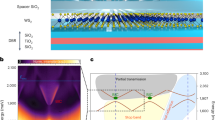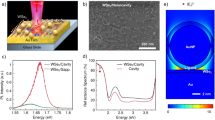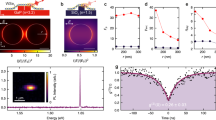Abstract
Exciton polaritons that arise through the strong coupling of excitons and cavity photons are used to demonstrate a wide array of fundamental phenomena and potential applications that range from Bose–Einstein-like condensation1,2,3 to analogue Hamiltonian simulators4,5 and chip-scale interferometers6. Recently, the two-dimensional (2D) transition metal dichalcogenides (TMDs), because of their large exciton binding energies, oscillator strength and valley degree of freedom, have emerged as a very attractive platform to realize exciton polaritons at elevated temperatures7. Achieving the electrical injection of polaritons is attractive both as a precursor to realizing electrically driven polariton lasers as well as for high speed light-emitting diodes (LEDs) for communication systems. Here, we demonstrate an electrically driven polariton LED that operates at room temperature using monolayer tungsten disulfide (WS2) as the emissive material. The extracted external quantum efficiency is ~0.1% and is comparable to recent demonstrations of bulk organic8 and carbon nanotube-based polariton electroluminescence (EL) devices9. The possibility to realize electrically driven polariton LEDs in atomically thin semiconductors at room temperature presents a promising step towards achieving an inversionless electrically driven laser in these systems as well as for ultrafast microcavity LEDs using van der Waals (vdW) materials.
This is a preview of subscription content, access via your institution
Access options
Access Nature and 54 other Nature Portfolio journals
Get Nature+, our best-value online-access subscription
$29.99 / 30 days
cancel any time
Subscribe to this journal
Receive 12 print issues and online access
$259.00 per year
only $21.58 per issue
Buy this article
- Purchase on Springer Link
- Instant access to full article PDF
Prices may be subject to local taxes which are calculated during checkout




Similar content being viewed by others
Data availability
Data are available from the corresponding author upon reasonable request.
References
Kasprzak, J. et al. Bose–Einstein condensation of exciton polaritons. Nature 443, 409–414 (2006).
Balili, R., Hartwell, V., Snoke, D., Pfeiffer, L. & West, K. Bose–Einstein condensation of microcavity polaritons in a trap. Science 316, 1007–1010 (2007).
Deng, H., Weihs, G., Santori, C., Bloch, J. & Yamamoto, Y. Condensation of semiconductor microcavity exciton polaritons. Science 298, 199–202 (2002).
Berloff, N. G. et al. Realizing the classical XY Hamiltonian in polariton simulators. Nat. Mater. 16, 1120–1126 (2017).
Amo, A. & Bloch, J. Exciton-polaritons in lattices: a non-linear photonic simulator. C.R. Phys. 17, 934–945 (2016).
Sturm, C. et al. All-optical phase modulation in a cavity-polariton Mach–Zehnder interferometer. Nat. Commun. 5, 3278 (2014).
Schneider, C., Glazov, M. M., Korn, T., Höfling, S. & Urbaszek, B. Two-dimensional semiconductors in the regime of strong light–matter coupling. Nat. Commun. 9, 2695 (2018).
Gubbin, C. R., Maier, S. A. & Kéna-Cohen, S. Low-voltage polariton electroluminescence from an ultrastrongly coupled organic light-emitting diode. Appl. Phys. Lett. 104, 233302 (2014).
Graf, A. et al. Electrical pumping and tuning of exciton–polaritons in carbon nanotube microcavities. Nat. Mater. 16, 911–917 (2017).
Withers, F. et al. Light-emitting diodes by band-structure engineering in van der Waals heterostructures. Nat. Mater. 14, 301–306 (2015).
Withers, F. et al. WSe2 light-emitting tunneling transistors with enhanced brightness at room temperature. Nano Lett. 15, 8223–8228 (2015).
Choi, W. et al. Recent development of two-dimensional transition metal dichalcogenides and their applications. Mater. Today 20, 116 (2017).
Sun, Z. et al. Optical control of room-temperature valley polaritons. Nat. Photon. 11, 491–496 (2017).
Dufferwiel, S. et al. Valley-addressable polaritons in atomically thin semiconductors. Nat. Photon. 11, 497–501 (2017).
Chen, Y.-J., Cain, J. D., Stanev, T. K., Dravid, V. P. & Stern, N. P. Valley-polarized exciton–polaritons in a monolayer semiconductor. Nat. Photon 11, 431–435 (2017).
Lundt, N. et al. Valley polarized relaxation and upconversion luminescence from Tamm-plasmon trion–polaritons with a MoSe2 monolayer. 2D Mater. 4, 025096 (2017).
Sidler, M. et al. Fermi polaron–polaritons in charge-tunable atomically thin semiconductors. Nat. Phys. 13, 255–261 (2016).
Barachati, F. et al. Interacting polariton fluids in a monolayer of tungsten disulfide. Nat. Nanotechnol. 13, 906–909 (2018).
Sanvitto, D. & Kéna-Cohen, S. The road towards polaritonic devices. Nat. Mater. 15, 1061–1073 (2016).
Tsintzos, S. I., Pelekanos, N. T., Konstantinidis, G., Hatzopoulos, Z. & Savvidis, P. G. A GaAs polariton light-emitting diode operating near room temperature. Nature 453, 372–375 (2008).
Zhang, Z. et al. Exciton–polariton light-emitting diode based on a ZnO microwire. Opt. Express 25, 17375–17381 (2017).
Bajoni, D. et al. Polariton light-emitting diode in a GaAs-based microcavity. Phys. Rev. B 77, 113303 (2008).
Tischler, J. R., Bradley, M. S., Bulović, V., Song, J. H. & Nurmikko, A. Strong coupling in a microcavity LED. Phys. Rev. Lett. 95, 036401 (2005).
Lodden, G. H. & Holmes, R. J. Electrical excitation of microcavity polaritons by radiative pumping from a weakly coupled organic semiconductor. Phys. Rev. B 82, 125317 (2010).
Christogiannis, N. et al. Characterizing the electroluminescence emission from a strongly coupled organic semiconductor microcavity LED. Adv. Opt. Mater. 1, 503–509 (2013).
Chakraborty, B. et al. Control of strong light–matter interaction in monolayer WS2 through electric field gating. Nano Lett. 18, 6455–6460 (2018).
Lee, B. et al. Electrical tuning of exciton–plasmon polariton coupling in monolayer MoS2 integrated with plasmonic nanoantenna lattice. Nano Lett. 17, 4541–4547 (2017).
Zhong, D. et al. Van der Waals engineering of ferromagnetic semiconductor heterostructures for spin and valleytronics. Sci. Adv. 3, e1603113 (2017).
Xi, X. et al. Strongly enhanced charge-density-wave order in monolayer NbSe2. Nat. Nanotechnol. 10, 765–769 (2015).
Wang, Z. et al. MoTe2: a type-II Weyl topological metal. Phys. Rev. Lett. 117, 056805 (2016).
Wang, L. et al. One-dimensional electrical contact to a two-dimensional material. Science 342, 614–617 (2013).
Acknowledgements
We acknowledge support from the National Science Foundation through the Emerging Frontiers Research and Innovation-2DARE program (EFMA-1542863), the Materials Research Science and Engineering Centers program 420634 and the Army Research Office Multidisciplinary University Research Initiative program (W911NF-17-1-0312). The authors also acknowledge the use of the Nanofabrication Facility at the City University of New York Advanced Science Research Center for the fabrication of the devices.
Author information
Authors and Affiliations
Contributions
V.M.M., J.G. and B.C. conceived the experiments. J.G., B.C. and M.K. fabricated the devices and performed the measurements. B.C., J.G. and V.M.M. performed data analysis. All the authors contributed to write the manuscript and discuss the results.
Corresponding author
Ethics declarations
Competing interests
The authors declare no competing interests.
Additional information
Publisher’s note Springer Nature remains neutral with regard to jurisdictional claims in published maps and institutional affiliations.
Supplementary information
Supplementary information for: A room-temperature polariton light-emitting diode based on monolayer WS2
Supplementary Sections 1–7 and Figs. 1–6.
Rights and permissions
About this article
Cite this article
Gu, J., Chakraborty, B., Khatoniar, M. et al. A room-temperature polariton light-emitting diode based on monolayer WS2. Nat. Nanotechnol. 14, 1024–1028 (2019). https://doi.org/10.1038/s41565-019-0543-6
Received:
Accepted:
Published:
Issue Date:
DOI: https://doi.org/10.1038/s41565-019-0543-6
This article is cited by
-
Energy transfer driven brightening of MoS2 by ultrafast polariton relaxation in microcavity MoS2/hBN/WS2 heterostructures
Nature Communications (2024)
-
Deep learning in two-dimensional materials: Characterization, prediction, and design
Frontiers of Physics (2024)
-
Dynamical characteristics of AC-driven hybrid WSe2 monolayer/AlGaInP quantum wells light-emitting device
Discover Nano (2023)
-
Charged biexciton polaritons sustaining strong nonlinearity in 2D semiconductor-based nanocavities
Nature Communications (2023)
-
Exciton polariton interactions in Van der Waals superlattices at room temperature
Nature Communications (2023)



